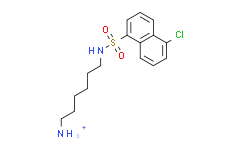| 中文名称: | N-(6-氨基己基)-5-氯-1-萘磺酰胺盐酸盐 | ||||
|---|---|---|---|---|---|
| 英文名称: | N-(6-Aminohexyl)-5-chloro-1-naphthalenesulfonamide Hydrochloride | ||||
| 别名: | N-(6-氨基己基)-5-氯-1-萘磺酰胺盐酸盐 W-7 Hydrochloride | ||||
| CAS No: | 61714-27-0 | 分子式: | C16H21ClN2O2S.HCl | 分子量: | 377.32 |
| CAS No: | 61714-27-0 | ||||
| 分子式: | C16H21ClN2O2S.HCl | ||||
| 分子量: | 377.32 | ||||
| MDL: | MFCD00012559 | ||||
基本信息
|
产品编号: |
A10874 |
||||
|
产品名称: |
W-7 Hydrochloride |
||||
|
CAS: |
61714-27-0 |
储存条件 |
粉末 |
2-8℃ |
四年 |
|
|
|
||||
|
分子式: |
溶于液体 |
-80℃ |
六个月 |
||
|
分子量 |
377.32 |
-20℃ |
一个月 |
||
|
化学名: |
N-(6-Aminohexyl)-5-chloro-1-naphthalenesulfonamide Hydrochloride |
||||
|
Solubility (25°C): |
|||||
|
体外:
|
DMSO |
250mg/mL (662.55mM; Need ultrasonic) |
|||
|
Ethanol |
|
||||
|
Water |
1.43mg/mL (3.79mM; ultrasonic and warming and heat to 60°C) |
||||
|
体内(现配现用): |
1.请依序添加每种溶剂:10% DMSO→40% PEG300→5% Tween-80→45% saline Solubility: ≥ 2.08mg/mL (5.51mM); Clear solution |
||||
|
此⽅案可获得 ≥ 2.08mg/mL (5.51mM,饱和度未知) 的澄清溶液。 以 1mL ⼯作液为例,取 100μL 20.8mg/mL 的澄清 DMSO 储备液加到 400μL PEG300 中,混合均匀;向上述体系中加⼊ 50μL Tween-80,混合均匀;然后继续加⼊ 450μL ⽣理盐⽔定容⾄ 1mL。 |
|||||
|
2.请依序添加每种溶剂:10% DMSO→90% (20% SBE-β-CD in saline) Solubility: ≥ 2.08mg/mL (5.51mM); Clear solution |
|||||
|
此⽅案可获得 ≥ 2.08mg/mL (5.51mM,饱和度未知) 的澄清溶液。以 1mL ⼯作液为例,取 100μL 20.8mg/mL 的澄清 DMSO 储备液加到 900μL 20% 的 SBE-β-CD ⽣理盐⽔⽔溶液中,混合均匀。 |
|||||
|
3.请依序添加每种溶剂:10% DMSO→90% corn oil Solubility: ≥ 2.08mg/mL (5.51mM); Clear solution |
|||||
|
此⽅案可获得 ≥ 2.08mg/mL (5.51mM,饱和度未知) 的澄清溶液,此⽅案不适⽤于实验周期在半个⽉以上的实验。 以 1mL ⼯作液为例,取 100μL 20.8mg/mL 的澄清 DMSO 储备液加到 900μL ⽟⽶油中,混合均匀。 |
|||||
|
<1mg/ml表示微溶或不溶。 |
|||||
|
普西唐提供的所有化合物浓度为内部测试所得,实际溶液度可能与公布值有所偏差,属于正常的批间细微差异现象。 |
|||||
|
请根据产品在不同溶剂中的溶解度选择合适的溶剂配制储备液;⼀旦配成溶液,请分装保存,避免反复冻融造成的产品失效。 |
|||||
制备储备液
|
浓度
溶液体积 质量 |
1mg |
5mg |
10mg |
|
1mM |
2.6502mL |
13.2510mL |
26.5020mL |
|
5mM |
0.5300mL |
2.6502mL |
5.3004mL |
|
10mM |
0.2650mL |
1.3251mL |
2.6502mL |
生物活性
|
产品描述 |
W-7 hydrochloride 是⼀种选择性的钙调蛋⽩ (calmodulin) 拮抗剂。W-7 hydrochloride 抑制 Ca2+ -钙调蛋⽩依赖性磷酸⼆ 酯酶 (phosphodiesterase) 和肌球蛋⽩轻链激酶 (myosin light chain kinase),IC50 值分别为 28μM 和 51μM。W-7 hydrochloride 可诱导细胞凋亡 (apoptosis),并具有抗癌活性。 |
|
|
靶点 |
IC50: 28μM (Phosphodiesterase) and 51μM (Myosin light chain kinase) |
|
|
体外研究 |
W-7 is distributed mainly in the cytoplasm, and inhibits proliferation of Chinese hamster ovary K1 (CHO-K1) cells. W-7 selectively blocks the phase of the cell cycle (G1/S boundary phase) in a manner. 25μM W-7 arrests the growth of the cells at the G1/S boundary phase of the cell cycle. W-7 (100μM) exhibits a similar extent of antagonism between the contractile responses to carbachol and KCl. The increase in myosin light chain (P-LC) phosphate content in response to 1-min stimulation with 10μM carbachol is inhibited by W-7. W-7 antagonizes the smooth muscle contraction through the inhibition of the initial increase in the P-LC phosphorylation. Treatment with W-7 results in the dose-dependent inhibition of cell proliferation in various human multiple myeloma cell lines. W-7 induces G1 phase cell cycle arrest by downregulating cyclins and upregulating p21cip1. W-7 induces apoptosis via caspase activation; this occurred partly through the elevation of intracellular calcium levels and mitochondrial membrane potential depolarization and through inhibition of the STAT3 phosphorylation and subsequent downregulation of Mcl-1 protein. W-7 competitively inhibits Ca2+/calmodulin-dependent phosphodiesterase with a Ki value of 300μM |
|
|
体内研究 |
W-7 (3mg/kg; intraperitoneal injection; on 5 consecutive days per week; female BALB/c nu mice) treatment significantly reduces tumor growth in a murinemM model |
|
|
Animal Model: |
Female BALB/c nu mice (6-week-old) injected with RPMI 8226 cells |
|
|
Dosage: |
3mg/kg |
|
|
Administration: |
Intraperitoneal injection; on 5 consecutive days per week |
|
|
Result: |
Significantly reduced tumor growth in a murine MM model. |
|
本计算器可帮助您计算出特定溶液中溶质的质量、溶液浓度和体积之间的关系,公式为:
质量 (g) = 浓度 (mol/L) x 体积 (L) x 分子量 (g/mol)
摩尔浓度计算公式
用本工具协助配置特定浓度的溶液,使用的计算公式为:
开始浓度 x 开始体积 = 最终浓度 x 最终体积
稀释公式
稀释公式一般简略地表示为:C1V1 = C2V2 ( 输入 输出 )








